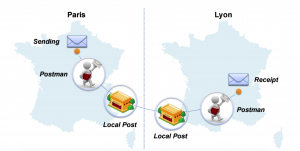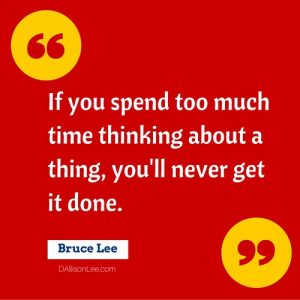Anyone leading a well-established business faces the challenge of needing to innovate within a large organization while still getting the day-to-day business done. It’s not easy. Innovation is risky. It involves change. And in the heat of battle, it’s tempting to put innovation on the back burner.
As someone who built my early career at PepsiCo, I always gravitated to the unknown, and―let’s face it―I enjoyed disrupting the status quo. I had to find ways to innovate on big brands and convince the company to back those efforts (my bosses helped a lot with the latter!). At the same time, I thought of it as deliciously subversive behavior, but looking back on it now, I understand that PepsiCo fully supported its employees and innovation. I was fortunate to have worked there.
Today, I wanted to share some best practices that helped me rise above the day-to-day work to innovate more successfully. I’ll call them “Periscopes.”
Three “Periscope” Innovation Best Practices
1. Look for “Eureka Moments”
Eureka moments are insights that cause you to see something new, different, and profound about your consumers. Often they turn conventional wisdom on its head and reveal big untapped opportunities.
- Ask provocative, even naïve questions.
What would it take for our product to be ten times as good as it is today? What would it take to be known as the best service provider in America? CEOs and new employees tend to be good at this. So are outside thought partners.
Questioning can happen as part of a formal process or opportunistically, but there needs to be a process to ensure the best ideas get developed and tested.
- Question your most deeply held assumptions.
Sacred cows are a great place to start.
At Frito Lay, back in the days when mom was the main grocery shopper, we traditionally targeted female heads of household for Fritos, because we believed moms were buying corn chips for their kids’ lunches. Then we asked a different question―who is actually eating Fritos? It turned out that dads were the real heavy users, so we changed our marketing to target them.
Ask questions like: Do we have the right target audience? Is there a new audience that we have not thought about? Has the value proposition changed in some way?\Is there a different benefit we haven’t considered?
- Search outside your industry.
Someone somewhere has solved your problem before.
The King County Library System wanted to make it easier for patrons to find materials on their own, without having to ask a librarian or search a catalog.
We interviewed Disney on how they managed way-finding at their theme parks. We looked at how the British Museum helped visitors from all over the world find the highlights of their collection. We looked at how hospitals channeled people to the emergency room when they needed urgent care in a crisis. Those insights led to innovation best practices that KCLS used in designing their new libraries.
2. Set Your Innovation Thinking Free
People often become too anchored to how their company operates in the present day, which can make it difficult to envision breakthrough possibilities for the future. To free your team from this trap and find innovation, create structured ways for them to break out of their day-to-day mindsets.
Your competitors will take your future from you if you don’t seize it for yourself.
- Imagine your success far into the future.
I worked with the division of a technology company whose leader wanted to get her team thinking in more strategic and longitudinal ways.
To prepare for a strategic planning session, I asked team members to gather and synthesize facts that would be important for the discussion. They came to the session primed to contribute.
We started the session with this question: “It’s 20 years from now. You’re about to give a talk and your company is being recognized for a major achievement. Where are you―being interviewed by Fortune? On stage at TED? Accepting a Nobel Prize? What did your company do and why was it so special?”
At the meeting, we talked about their various visions of success.
That exercise opened up a more robust discussion about what goals would make sense for the division longer term and what strategies would be required to achieve them. They weren’t constrained by what they thought they could or couldn’t do. Their leader was able to use this discussion to set the division’s future direction with the team engaged and fully prepared to act.
- Alternatively, return to the past.
What was the passionate spark, the core purpose that got your company started? Have your employees lost that narrative?
Starbucks at one point considered going into furniture―that business didn’t leverage their core equities. CEO Howard Schultz brought them back to their roots, saying, “We are about the coffeehouse experience―about community, a place for people to get together and exchange ideas.” They changed their mission statement to:
“To inspire and nurture the human spirit – one person, one cup, and one neighborhood at a time.”
This statement is far more inspiring than “Let’s go for five more share points.”
On a practical note, when you engage your team around the bigger purpose your company or brand serves, they can make better strategic decisions and it will help them decide what belongs and what doesn’t belong on their priority lists.
- Ask questions that force you out of your normal point of view.
For example: Imagine you are a startup company in your market. What would you do and what innovation could you create to disrupt your industry?
Or pretend you are your most hated or feared competitor. What could that rival do to take your company down?
Or pretend you are a market leader from another country, entering your market. How might they approach the opportunity?
Then ask what might that imply for you next innovation and what you can do differently.
3. Invite Focused Play into You Office
Offer opportunities for focused play, to create a climate for your employees to attack your most pressing business problems in unstructured, non-traditional ways.
The 2010 Nobel Prize for physics went to Andre Geim and Konstantin Novoselov for their work on graphene, a material which is expected to revolutionize the electronics industry.
Their lab had a Friday afternoon tradition of doing crazy experiments, and that’s where their breakthrough began. The Nobel committee cited the scientists’ playfulness when they awarded the prize.
Neuroscience shows our brains work better when they are relaxed. Companies need ways to encourage creativity and help employees make unexpected connections that lead to big ideas, solutions, and innovation.
- Conduct special work events to tackle an important problem.
Curaspan Health Group organized a weekend hackathon where employees created apps to deliver better health care. The winning project was funded and the winners got the opportunity to lead the project.
Once a year, or even once a quarter, you might consider setting aside a day to form teams and solve a particular problem. Offer a prize to the one with the most usefulness. Or consider an employee choice award. Either way, make sure the solution is acted upon and the right people are rewarded.
- Incorporate play on a small scale during brainstorming sessions.
Try brainstorming sessions for when your team is kicking off a project or when they have hit the wall on a particular problem.
Create exercises that purposefully invite exaggeration to make people comfortable sharing their closer-in ideas, for example. Set the innovation climate for everyone to feel comfortable, particularly introverts who need time to process their ideas on their own before discussing them.
The Beauty of These Practices
They don’t cost much. Just a mind shift.
I’d love to hear what other practices you find helpful.
Business & Finance Articles on Business 2 Community(59)






